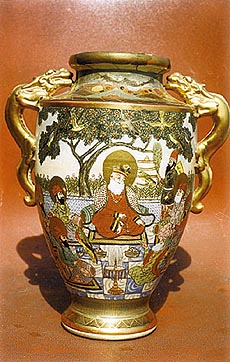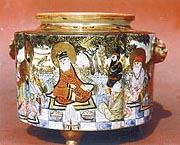

 
 


 
 
|
A Satsuma
riddle
By G.S.
Cheema
AMONG the various exhibits on
display in the exhibitions put up by the Punjab
Government at Anandpur Sahib and Chandigarh were some
pieces of Japanese ceramics — or to be more precise,
Satsuma faience ware — bearing the pictures of the
ten Gurus. Dated at 1875, or thereabouts, no pieces of
this kind have been noticed before, though, undoubtedly,
others must also have been made. The items are two
identical vases or jars, obviously a pair, and a smaller
pot which may have been intended to be a sugar or tea
caddy. So while the smaller item may have been part of a
tea-set, the vases are purely decorative, and presumably
the client must have ordered a number of them to be given
away as presentation pieces.
 Who was
the client? Obviously it had to be a Sikh gentleman of
means. The present owner is one Sardar Atamjit Singh, a
resident of Dehra Dun, and scion of an old sardar family.
But he readily admits that these pieces of Satsuma ware
are not old heirlooms discovered in some store room of an
ancestral haveli which had somehow survived the
vicissitudes of time and fortune. They were picked up by
him from a Bombay antiquarian in the mid sixties, and
according to the dealer he had, in turn, acquired them at
an auction in Hyderabad. There were indeed some Sikh
gentlemen in the service of His Exalted Highness. The
items may have reached the Deccan through them. Maharaja
Ripudaman Singh, the dispossessed ruler of Nabha lived in
exile at Kodaikanaal. Perhaps they may have been his, and
after his death they might have changed hands and reached
Hyderabad. Many of the nobles of the Nizam were extremely
rich, and there were many collectors and men of taste in
this city —the last relic of the Mughal Empire
— besides the redoubtable Salar Jang III. Who knows?
But it is difficult to think of anyone outside the small
circle of the Sikh princes who could have placed an order
for such pieces; so small was the class among the Sikhs
who had the taste and the means — at least circa
1875. Who was
the client? Obviously it had to be a Sikh gentleman of
means. The present owner is one Sardar Atamjit Singh, a
resident of Dehra Dun, and scion of an old sardar family.
But he readily admits that these pieces of Satsuma ware
are not old heirlooms discovered in some store room of an
ancestral haveli which had somehow survived the
vicissitudes of time and fortune. They were picked up by
him from a Bombay antiquarian in the mid sixties, and
according to the dealer he had, in turn, acquired them at
an auction in Hyderabad. There were indeed some Sikh
gentlemen in the service of His Exalted Highness. The
items may have reached the Deccan through them. Maharaja
Ripudaman Singh, the dispossessed ruler of Nabha lived in
exile at Kodaikanaal. Perhaps they may have been his, and
after his death they might have changed hands and reached
Hyderabad. Many of the nobles of the Nizam were extremely
rich, and there were many collectors and men of taste in
this city —the last relic of the Mughal Empire
— besides the redoubtable Salar Jang III. Who knows?
But it is difficult to think of anyone outside the small
circle of the Sikh princes who could have placed an order
for such pieces; so small was the class among the Sikhs
who had the taste and the means — at least circa
1875.
Whereas Chinese
porcelain (and other ceramics, like faience) had been
imported into India and Europe for many centuries, Japan
was a relative newcomer in this field. After the Shimbara
rebellion of Christian converts in 1637, Japan had closed
its ports to foreign ships. Although a tenuous foreign
trade was maintained through the medium of the Dutch who
were allowed to maintain a trading post on a small island
under extremely humiliating conditions, Japan remained
virtually isolated, with its citizens prohibited from
travelling abroad. That is until Commodore Perry with his
armed cruisers entered Tokyo Bay in 1854, and, after a
preliminary shelling, forced the Japanese to open their
ports. This was the USA’s first major foreign
intervention, and, shall we say, an early victory in the
name of free trade?
The history of the
Satsuma potteries is an old one. They take their name
from a district whose capital is Kagoshima on the
southernmost island of Kyushu. It was towards the end of
the 16th century that the feudal prince or daimyo of
Satsuma, returning from a campaign in Korea, brought back
with him a number of Korean potters. One of these
discovered clay deposits of remarkable fineness near
Kagoshima, which became the basis of the prosperity of
the later potteries. One of these very Koreans was also
destined to found a great samurai family and Admiral
Yamamoto, the architect of the triumph of Pearl Harbour,
was one of his descendants. But that is another story.
 In the later nineteenth century, Satsuma
ware was in vogue in the European market. It was
characterised by a sombre cream or ivory ground, covered
with a network of fine crackles with enameling and
gilding. The enamels used were red, green blue, purple,
gold, black and yellow. But much of what passed as
Satsuma ware, specially the second grade stuff, was not
really made at Satsuma, but at Kyoto, Tokyo and Yokohama.
In Japan itself this later nineteenth century Satsuma
ware was not too highly valued. It was too closely
attuned to the requirements of the European market. Today
it has lost much of its old reputation, even there. In the later nineteenth century, Satsuma
ware was in vogue in the European market. It was
characterised by a sombre cream or ivory ground, covered
with a network of fine crackles with enameling and
gilding. The enamels used were red, green blue, purple,
gold, black and yellow. But much of what passed as
Satsuma ware, specially the second grade stuff, was not
really made at Satsuma, but at Kyoto, Tokyo and Yokohama.
In Japan itself this later nineteenth century Satsuma
ware was not too highly valued. It was too closely
attuned to the requirements of the European market. Today
it has lost much of its old reputation, even there.
But these pieces are
undoubtedly exceptional. The drawing is strong, and in
spite of the number of figures, each is individualized.
Guru Nanak is easily recognisable and his pose, dress,
and general features are such as are depicted in most
early illustrations. Of course it will be objected that
the colour of his robes is rather unusual for a fakir,
but some allowance must be made for the Satsuma
works’ desire to advertise their mastery of enamel
colours. His expression too is that of a placid and
kindly old man, rather than that of a spiritually exalted
guru. One is reminded of the Laughing Buddha; Sobha
Singh, certainly, would not have approved!
The hawk (or falcon ) on
the wrist of Guru Gobind Singh is also curiously
coloured. But apart from these errors it is a charming
scene. The Guru is seated on a mansard, laid out on a
marble terrace, his back supported by a gao takkiah,
under a pleasant fruit tree, with magical, golden birds
flying about. A nightingale warbles its song from its
golden cage, while Bala stands on the Guru’s left
— his usual place-waning a murchhal, or
peacock feather fan. You have here echoes of ancient
myth, Persian poetry, and the gardens of Firdaus or
Paradise.
The drawing must have
been copied or adapted from some picture furnished by the
client. Copied by a Japanese artist on to the faience
surface, it has undergone subtle changes. We are familiar
with the pictures of the Gurus as drawn and painted by
miniaturists of the Pahari and Sikh schools. We are also
familiar with the paintings of G.S. Sohan Singh and Sobha
Singh, besides the large canvases of historical scenes
painted by Kirpal Singh, Devinder Singh and others. But
here on these Satsuma vases we have a uniquely Japanese
interpretation!
|

![]()

